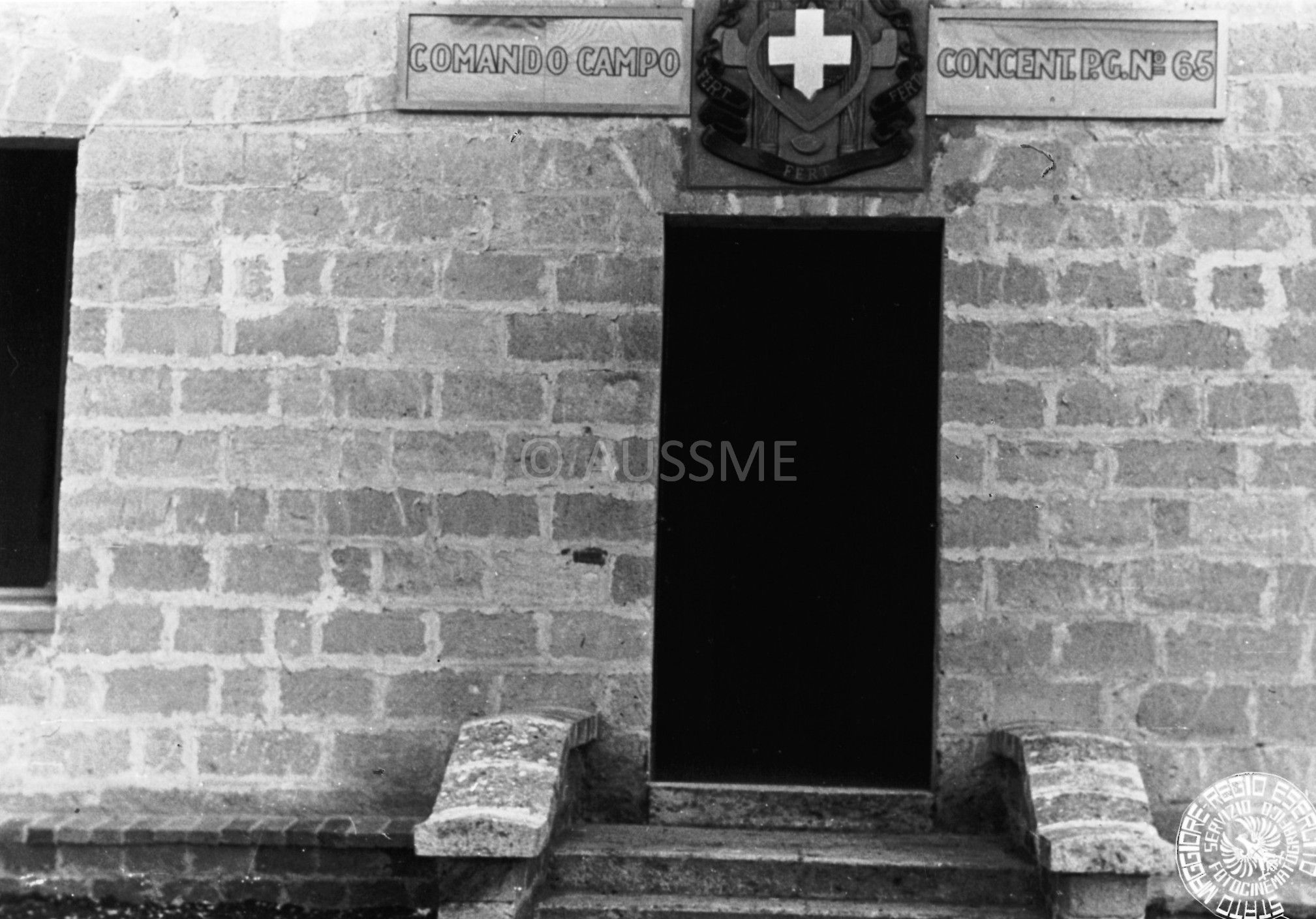Sheet by: Isabella Insolvibile

Entrance to the command post of concentration camp No. 65 in Gravina di Puglia (BA) - AUSSME Archive, Fototeca 2 Guerra Mondiale Italia 507/633
General data
Town: Altamura
Province: Bari
Region: Puglia
Location/Address: Lama Sambuco - Altamura
Type of camp: Prisoner of War camp
Number: 65
Italian military mail service number: 3450
Intended to: NCOs – Troops
Local jurisdiction: IX Army Corps
Railroad station: Gravina di Puglia
Accommodation: Huts
Capacity: 12000
Operating: from 04/1942 to 06/1943
Commanding Officer: Col. Vincenzo Cione (April – June 1942), Lt. Col. Attilio Coppola (July 1942 – July 1943)
Brief chronology:
April 1942: the camp was opened.
17 May 1942: PoW M.C. Moore died.
July 1942: the PoWs were used as workers on construction sites and farms.
December 1942: PoW Bernard Andrew Foyster died.
Spring 1943: a group of PoWs was employed at Foggia airport.
July 1943: the camp was closed.
Allied prisoners in the Altamura camp
| Date | Officers | NCOs | Troops | TOT |
| 1.4.1942 | 80 | 1246 | 1326 | |
| 1.5.1942 | 93 | 1374 | 1467 | |
| 1.6.1942 | 324 | 3153 | 3477 | |
| 1.7.1942 | 316 | 3340 | 3656 | |
| 1.8.1942 | 9 | 528 | 5780 | 6317[1] |
| 1.9.1942 | 9 | 507 | 5536 | 6052[2] |
| 30.9.1942 | 9 | 491 | 5284 | 5784[3] |
| 31.10.1942 | 9 | 528 | 6385 | 6922 |
| 30.11.1942 | 11 | 683 | 7233 | 7927 |
| 31.12.1942 | 11 | 693 | 7620 | 8324 |
| 31.1.1943 | 11 | 747 | 8025 | 8783 |
| 28.2.1943 | 11 | 647 | 7905 | 8563 |
| 31.3.1943 | 11 | 726 | 7797 | 8534 |
| 30.4.1943 | 10 | 687 | 5868 | 6565 |
| 31.5.1943 | 10 | 628 | 4673 | 5311 |
| 30.6.1943 | 10 | 12 | 2419 | 2441 |
Camp’s overview
Altamura-Gravina PoW camp was the largest in Italy. It was, with the sole exclusion of the camps in the Abruzzo region, the only permanent camp in southern Italy, as the others were all transit camps. Even though the source at our disposal labelled this camp as «Gravina», it was erected inside the territory of the Altamura municipality.
The camp opened in April 1942 and was described by the British PoWs held there as «Hell on Earth» (TNA, TS 26/95). Food rations were inadequate, and the camp was overcrowded and dirty, all things that led to the death of PoWs. Even though the huts in PG 65 were made of stone, the camp was afflicted by humidity and mud, just like any other camp in the south of Italy. Moreover, the camp was built near a swamp, meaning that malaria was constantly present. In other words, it was a camp fully representative of the Italian PoW camps’ standards. Corporal John Cheetham, who arrived from Africa in July 1942, described it:
The prisoners were grouped into sectors according to their nationality. When Cheetham was there, for example, there were two sectors for the British, one for the Cypriots and other PoWs from the eastern Mediterranean, and a middle section where the cookhouses and lavatories were. The relations between the various PoW groups in the close quarters of the camp were not always easy.
Structurally, the camp presented various issues that endured: the hydro system was not functional, resulting in problems with sewage and showers, and food supplies were discontinuous. In the spring of 1942, the Direzione militare of the IX Army Corps noted:
As mentioned, these issues were never solved. Witnesses were unanimous in claiming that, in the camp, some deaths were due to malnutrition and especially illnesses – in particular dysentery and diphtheria – which were not adequately treated because of the lack of medicines and medical equipment. On 17 May 1942, New Zealander Corporal M.C. Moore died as a result of these conditions. As reported by a witness:
Moore was not the only PoW who died in this period. The terrible living conditions were made worse by overcrowding, lack of adequate hygienic services, running water, and the presence of many parasites. Another PoW testified that:
This situation was compounded by the guards’ neglect of the PoWs, which caused many deaths. In December 1942, Engineer Foyster died, as reported by the British Senior Officer, a South African Medical Officer:
In July 1942, the PoWs were put to work – legally, according to the Geneva Conventions – mostly in farms or small building companies. However, they were also employed in illegal jobs, like the group forced to work at the Foggia airport in 1943. Work was, technically, voluntary but it was often forced upon the PoWs as a form of extortion by their captors; as a prisoner reported: «we were deliberately starved by the Italians in camp 65 to make us go to work for said Italians on their farms» [TNA, WO 344/11/2]. The PoWs, in any case, were vigilant about which jobs they were legally allowed to do and which they were not. A sailor reported that:
The prisoners took part in sabotage and strikes. For example, they destroyed the crops to protest at being forced to work. Moreover, escape attempts were frequent, and punishment was swift and brutal. Private McBean, who tried to escape four times, was beaten by some carabinieri because he refused to reveal where he had hidden the pliers he used to cut the barbed wire.
In March 1943, the representatives of the Protecting Power were allowed back in the camp after a long period during which the Italians had unilaterally forbidden inspections in all southern camps. At the time, PG 65 housed 8,639 PoWs in four sectors divided by barbed wire, and two more were still being built. Despite the fact that the camp would accommodate up to 12,000 PoWs, the works to expand it never ended. It continued to be overcrowded, with primitive hygienic structures and muddy external areas that became unusable on rainy days. Moreover, there was a complete lack of spaces for religious services, training courses or lessons. However, there was a small theatre and a boxing ring; the camp had four small music bands and a football field under construction. The prisoners also printed their own newspaper. Despite this, they suffered from the lack of supplies, beds, heating, and even straw to renew their mattresses. Despite the constant presence of parasites in the camp, there was no disinfestation service. On top of this, the prisoners also suffered from the lack of water, Red Cross parcels, and, consequently, because of the poverty of their diet. This was true, naturally, for medicines and nursing equipment as well.
Obviously, the PoWs kept getting sick, and some died. Fourteen died between May 1942 and May 1943, mainly because of diphtheria and malaria. Quinine supplies, like everything else, were insufficient, and the camp resorted to asking the Red Cross for help in providing medicines, anaesthetics and disinfectants.
These terrible conditions made relations between the PoWs and the guards very tense. According to the former, the latter made everything in their power to make the situation worse. For example, they regularly kicked the PoWs’ tea tins and put out the fires they lit with difficulty to heat beverages or cook the food they received in the Red Cross parcels.
When the PoWs started being transferred to other camps, as PG 65 was about to be closed, PoWs’ living conditions improved drastically. The camp was definitively abandoned after the Allied landing in Sicily and officially closed at the end of July 1943.
PG 65 remained in the PoWs’ memory as one of the worst in Italy. After the war, the long list of complaints led to many investigations of supposed war crimes in the camp. Among them was the wounding of South African private J.A.C. Venter in March 1943. During the roll call, a guard hit Venter in the stomach using the bayonet mounted on his rifle. According to the victim, the incident happened after roll call, during a search of the storehouse where the Red Cross parcels were kept. The prisoners were watching the Italians, as they feared that the carabinieri could steal the parcels – as was pretty standard, apparently – and a guard ordered them to move away, wounding Venter with his bayonet. He was treated by the South African camp medic and then brought to the Altamura hospital with a severe wound. The camp’s commander, Lt. Col. Coppola, instead, insisted that the incident happened because the prisoner attempted to leave his hut during roll call. He was confronted by a guard who, overpowered by the prisoner, reacted by wounding him.
PoWs were also harmed during escape attempts or due to disproportionate punishment inflicted by the captors – prisoners were confined to a 6x9m cell, in which up to 30 people were crammed simultaneously. There were also beatings and torture. Injuries and illnesses also occurred because of the terrible conditions, working prohibited jobs, the lack of food, the neglect suffered when ill, and the confiscation of personal goods.
Col. Vincenzo Cione was considered the main person responsible for the violations of the Geneva conventions in the camp. He, however, never faced trial, as the Germans murdered him in Colle di Compito right after the Armistice. His successor, Lt. Col. Attilio Coppola, was also investigated, but he was never prosecuted.
After the Armistice, the Allies used the camp for training and, after the war, it became a refugee camp, operational until 1962. The last remnants of the camp were demolished at the beginning of the 1990s and today the area is being reclassified, thanks to the interest of «Associazione campo 65».
Archival sources
- Archivio Apostolico Vaticano, IAC, UIV, Sez. prig. ingl., b. 443
- Archivio Centrale dello Stato, Ministero dell’Interno, Direzione Generale Pubblica Sicurezza, A5G, II GM, bb. 116, 117, 118 e 140, Verbali e Notiziari della Commissione Interministeriale per i Prigionieri di Guerra
- Archivio Centrale dello Stato, Ministero dell’Aeronautica, Gabinetto, b. 70, Verbali e Notiziari della Commissione Interministeriale per i Prigionieri di Guerra
- Archivio Ufficio Storico Stato Maggiore dell’Esercito, L10, b. 32
- Archivio Ufficio Storico Stato Maggiore dell’Esercito, M7, b. 3131
- Archivio Ufficio Storico Stato Maggiore dell’Esercito, H8, b. 79
- The National Archives, WO 361/1898
- The National Archives, WO 311/317, 1206
- The National Archives, WO 224/127
- The National Archives, TS 26/95, 713, 744
- The National Archives, WO 344 vari
- The National Archives, WO 310/13
Bibliography
- Associazione Campo 65 (a cura di), Campo 65. La memoria che resta, 2020
- Cheetham J. , Italian Interlude. The experiences of a prisoner-of-war in Italy July 1942-June 1944, s.l., s.n., [2000]
- De Felice G., Archeologia di un paesaggio contemporaneo. Le guerre del Novecento nella Murgia pugliese, Bari-S. Spirito, Edipuglia, 2020
- Horn K., In enemy hands. South Africa’s POWs in World War II, Johannesburg & Cape Town, Jonathan Ball Publishers, 2015
- Insolvibile I., I prigionieri alleati in Italia 1940-1943, tesi di dottorato, Dottorato in "Innovazione e Gestione delle Risorse Pubbliche", curriculum “Scienze Umane, Storiche e della Formazione”, Storia Contemporanea, Università degli Studi del Molise, anno accademico 2019-2020,
- Ipsaic (a cura di), Puglia. In viaggio nella memoria. Tra i luoghi dell'antifascismo della resistenza e dell'accoglienza, Bari, Edizioni del Sud , 2021
- Makepeace C., Captives of War. British Prisoners of War in Europe in the Second World War, Cambridge, Cambridge University Press, 2017
- Minardi M. (a cura di), Prigionieri in Italia. Militari alleati e campi di prigionia (1940-1945), Parma, MUP, 2021
Online resources
- https://archives.msmtrust.org.uk/?s=altamura, in archives.msmtrust.org.uk
- https://archives.msmtrust.org.uk/?s=gravina, in archives.msmtrust.org.uk
- https://campifascisti.it/scheda_campo.php?id_campo=357, in campifascisti.it
- https://www.cwgc.org/find-war-dead/casualty/2076564/moore,-morris-clayton/, in cwgc.org
- https://www.cwgc.org/find/find-war-dead/results?cemetery=Bari%2BWar%2BCemetery&dateFrom=01-08- 1942&dateTo=01-09-1942, in cwgc.org
- https://www.facebook.com/groups/181001789471530/, in facebook.com
